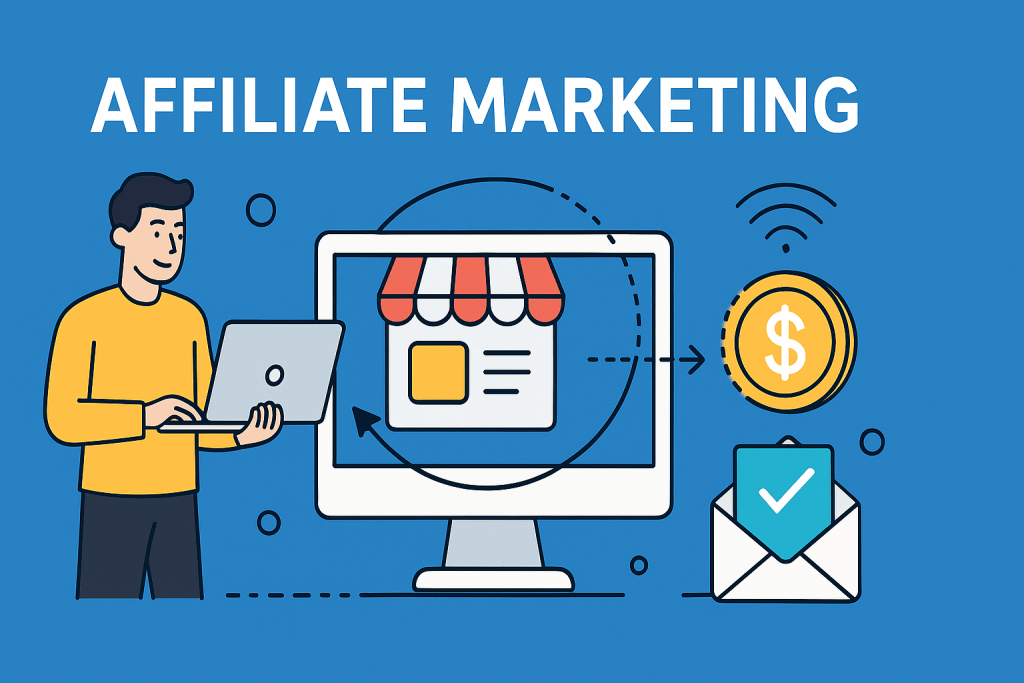Introduction:
In the ever-expanding world of digital business, people are always looking for new ways to generate passive income. Affiliate marketing is among the most well-liked and successful tactics. However, what is affiliate marketing?, and how can it boost your online income? This comprehensive guide will explain everything in simple, practical terms.
Whether you’re a blogger, content creator, digital entrepreneur, or someone just starting out, understanding what is affiliate marketing? can open up powerful earning opportunities.
Table of Contents
What is Affiliate Marketing?

At its core, affiliate marketing is a performance-based marketing strategy where individuals (affiliates) earn a commission by promoting a company’s products or services.
In simple words, you promote someone else’s product, and if people buy through your unique affiliate link, you earn a commission. You don’t have to make a product, keep stock, or worry about delivery.
So, what is affiliate marketing? It’s a win-win model for brands and marketers. Companies get more customers, and affiliates get paid for helping make sales.
How Affiliate Marketing Works:
The process of affiliate marketing can be broken down into four simple steps:
Step 1: Join an Affiliate Program
First, you register for an affiliate program or network. Many companies offer these programs, such as Amazon, Flipkart, ShareASale, CJ Affiliate, etc.
Step 2: Get Your Unique Affiliate Link
Once accepted, you receive a unique tracking link (affiliate link). This link is how the company tracks who referred the customer.
Step 3: Promote the Product or Service
You can promote the affiliate link through your blog, website, social media, YouTube, or email marketing.
Step 4: Earn a Commission
When someone clicks on your link and makes a purchase (or performs another action like signing up), you earn a percentage of the sale.
This is what affiliate marketing? is all about — promoting and earning.
The Main Players in Affiliate Marketing:
To understand what is affiliate marketing?, you need to know who’s involved in the process.
1. The Merchant (Seller or Brand)
This is the company that creates the product. They offer affiliate programs to expand their reach.
2. The Affiliate (You)
You are the marketer who promotes the product using a unique link.
3. The Consumer
The person who sees your content, clicks the link, and completes a purchase.
4. The Affiliate Network (Optional)
Some companies work through affiliate networks like ClickBank, Commission Junction, or Impact. These platforms connect affiliates with multiple brands.
Types of Affiliate Marketing:
Not all affiliate marketing is the same. Based on involvement and transparency, it can be divided into:
1. Unattached Affiliate Marketing
You don’t personally use or relate to the product. You promote using paid ads or generic content. This is low-trust and low-effort.
2. Related Affiliate Marketing
You have some expertise in the niche but haven’t used the product. You depend on the audience’s trust and your authority..
3. Involved Affiliate Marketing
You use and truly believe in the product. You create in-depth reviews or tutorials. This builds high trust and conversion.
Understanding these types is crucial to mastering what is affiliate marketing? in practice.
Common Affiliate Marketing Channels:
- Affiliate marketers use various platforms to promote products. Here are the most common ones:
- 1. Blogging
- Bloggers write product reviews, tutorials, or “best of” lists that include affiliate links. Example: “Top 10 Web Hosting Providers”
- 2. YouTube
- YouTubers create unboxing, review, or tutorial videos and include affiliate links in the description.
- 3. Social Media
- Platforms like Instagram, Facebook, and Pinterest can be used for product promotion, especially if you have a strong following.
- 4. Email Marketing
- Email newsletters with product recommendations can be powerful if you have a loyal subscriber base.
- 5. Paid Advertising
- Google Ads, Facebook Ads, or native advertising can be used to drive traffic directly to your affiliate links (with some platform restrictions).
How to Start Affiliate Marketing:
Even if you’ve never done anything before, here’s how to get started:
Step 1: Pick Your Niche
Focus on a specific topic (health, tech, finance, fashion, etc.) where you have knowledge or interest.
Step 2: Build a Platform
To share your content, set up a blog, YouTube channel, or social media account.
Step 3: Choose Affiliate Programs
Join affiliate programs like:
- Amazon Associates
- Flipkart Affiliate
- Bluehost Affiliate
- Hostinger Affiliate
- ShareASale
- CJ Affiliate
Step 4: Create Valuable Content
Educate your audience. Help them solve problems. Don’t just sell — provide value.
Step 5: Promote Your Content
To increase traffic to your content, use SEO, social media marketing, email, and sponsored traffic.
Step 6: Analyze and Improve
To maximise performance, make use of resources like conversion tracking, affiliate dashboards, and Google Analytics.
It’s time to take action now that you know what is affiliate marketing?
Choosing the Right Affiliate Program:
Not all programs are created equal. Look for:
- Reputation of the merchant
- Commission rate (typically 5% to 50%)
- Cookie duration (how long your referral stays valid)
- Payout terms (monthly, threshold, etc.)
- Marketing support (banners, creatives)
Choosing the right partners is essential when you’re starting out in affiliate marketing.
Tips for Success in Affiliate Marketing:
Want to make money with affiliate marketing Follow these proven tips:
1. Be Honest
Only promote products you trust or have researched deeply.
2. Build Trust
Focus on educating, not just selling. Help first, sell second.
3. Focus on SEO
Ranking on Google brings long-term passive income.
4. Create Evergreen Content
Write content that stays relevant year-round.
5. Use Visuals
Infographics, images, and videos increase engagement.
6. Track Everything
Recognise what is and is not working and adjust your optimisation accordingly.
Mastering these practices is key to thriving in what is affiliate marketing as a full-time income source.
Benefits of Affiliate Marketing:
1. Low Startup Cost
No warehouse, no product development, and no inventory investment
2. Flexible Work Style
You can set your own hours and work from any location.
3. Passive Income
Once your content is live, it can earn for months or even years.
4. Scalability
Start small, and grow big. You can promote multiple products or build a team.
5. No Customer Support Needed
You’re not responsible for post-sale service — the brand handles it.
Clearly, understanding what is affiliate marketing? helps you tap into a highly rewarding business model.
Challenges in Affiliate Marketing:
Like any other business, affiliate marketing has its downsides.
1. Competition
Popular niches are very saturated.
2. Delayed Earnings
It may take time to earn your first dollar.
3. Affiliate Program Rules
Violating terms can get you banned.
4. Commission Cuts
Companies can change commission structures unexpectedly.
5. Dependency on Traffic
No traffic = no sales. SEO and promotion are essential.
While you explore what is affiliate marketing?, it’s important to remain consistent and patient.
Is Affiliate Marketing Right for You?
Affiliate marketing is perfect for:
- Bloggers
- YouTubers
- Social media influencers
- Freelancers
- Stay-at-home parents
- Side hustlers
If you’re looking for a low-investment, high-potential business model, then learning what is affiliate marketing? could be your best decision yet.
Final Thoughts:
So, what is affiliate marketing?
It’s a powerful method where anyone — with or without technical expertise — can start earning income online by promoting other people’s products. With the right niche, quality content, and persistent effort, affiliate marketing can turn into a full-time income stream.
Whether you’re a beginner or a seasoned marketer, now is the best time to step into the affiliate space. Just remember — value comes first, sales come later.
Start today. The internet is waiting.
